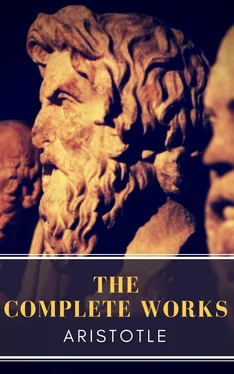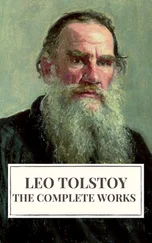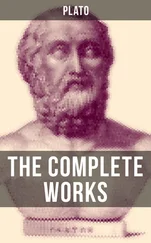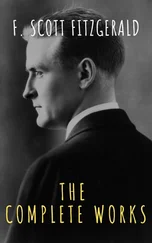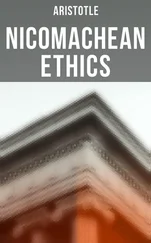Aristotle Aristotle - Aristotle - The Complete Works
Здесь есть возможность читать онлайн «Aristotle Aristotle - Aristotle - The Complete Works» — ознакомительный отрывок электронной книги совершенно бесплатно, а после прочтения отрывка купить полную версию. В некоторых случаях можно слушать аудио, скачать через торрент в формате fb2 и присутствует краткое содержание. Жанр: unrecognised, на английском языке. Описание произведения, (предисловие) а так же отзывы посетителей доступны на портале библиотеки ЛибКат.
- Название:Aristotle: The Complete Works
- Автор:
- Жанр:
- Год:неизвестен
- ISBN:нет данных
- Рейтинг книги:3 / 5. Голосов: 1
-
Избранное:Добавить в избранное
- Отзывы:
-
Ваша оценка:
- 60
- 1
- 2
- 3
- 4
- 5
Aristotle: The Complete Works: краткое содержание, описание и аннотация
Предлагаем к чтению аннотацию, описание, краткое содержание или предисловие (зависит от того, что написал сам автор книги «Aristotle: The Complete Works»). Если вы не нашли необходимую информацию о книге — напишите в комментариях, мы постараемся отыскать её.
This edition has been professionally formatted and contains several tables of contents. The first table of contents (at the very beginning of the ebook) lists the titles of all novels included in this volume. By clicking on one of those titles you will be redirected to the beginning of that work, where you'll find a new TOC that lists all the chapters and sub-chapters of that specific work.
Aristotle: The Complete Works — читать онлайн ознакомительный отрывок
Ниже представлен текст книги, разбитый по страницам. Система сохранения места последней прочитанной страницы, позволяет с удобством читать онлайн бесплатно книгу «Aristotle: The Complete Works», без необходимости каждый раз заново искать на чём Вы остановились. Поставьте закладку, и сможете в любой момент перейти на страницу, на которой закончили чтение.
Интервал:
Закладка:
These points will be made clearer by the sequel, when we discuss the reduction to impossibility: at present this much must be clear, that we must look to terms of the kinds mentioned whether we wish to use an ostensive syllogism or a reduction to impossibility. In the other hypothetical syllogisms, I mean those which proceed by substitution, or by positing a certain quality, the inquiry will be directed to the terms of the problem to be proved-not the terms of the original problem, but the new terms introduced; and the method of the inquiry will be the same as before. But we must consider and determine in how many ways hypothetical syllogisms are possible.
Each of the problems then can be proved in the manner described; but it is possible to establish some of them syllogistically in another way, e.g. universal problems by the inquiry which leads up to a particular conclusion, with the addition of an hypothesis. For if the Cs and the Gs should be identical, but E should be assumed to belong to the Gs only, then A would belong to every E: and again if the Ds and the Gs should be identical, but E should be predicated of the Gs only, it follows that A will belong to none of the Es. Clearly then we must consider the matter in this way also. The method is the same whether the relation is necessary or possible. For the inquiry will be the same, and the syllogism will proceed through terms arranged in the same order whether a possible or a pure proposition is proved. We must find in the case of possible relations, as well as terms that belong, terms which can belong though they actually do not: for we have proved that the syllogism which establishes a possible relation proceeds through these terms as well. Similarly also with the other modes of predication.
It is clear then from what has been said not only that all syllogisms can be formed in this way, but also that they cannot be formed in any other. For every syllogism has been proved to be formed through one of the aforementioned figures, and these cannot be composed through other terms than the consequents and antecedents of the terms in question: for from these we obtain the premisses and find the middle term. Consequently a syllogism cannot be formed by means of other terms.
30
The method is the same in all cases, in philosophy, in any art or study. We must look for the attributes and the subjects of both our terms, and we must supply ourselves with as many of these as possible, and consider them by means of the three terms, refuting statements in one way, confirming them in another, in the pursuit of truth starting from premisses in which the arrangement of the terms is in accordance with truth, while if we look for dialectical syllogisms we must start from probable premisses. The principles of syllogisms have been stated in general terms, both how they are characterized and how we must hunt for them, so as not to look to everything that is said about the terms of the problem or to the same points whether we are confirming or refuting, or again whether we are confirming of all or of some, and whether we are refuting of all or some. we must look to fewer points and they must be definite. We have also stated how we must select with reference to everything that is, e.g. about good or knowledge. But in each science the principles which are peculiar are the most numerous. Consequently it is the business of experience to give the principles which belong to each subject. I mean for example that astronomical experience supplies the principles of astronomical science: for once the phenomena were adequately apprehended, the demonstrations of astronomy were discovered. Similarly with any other art or science. Consequently, if the attributes of the thing are apprehended, our business will then be to exhibit readily the demonstrations. For if none of the true attributes of things had been omitted in the historical survey, we should be able to discover the proof and demonstrate everything which admitted of proof, and to make that clear, whose nature does not admit of proof.
In general then we have explained fairly well how we must select premisses: we have discussed the matter accurately in the treatise concerning dialectic.
31
It is easy to see that division into classes is a small part of the method we have described: for division is, so to speak, a weak syllogism; for what it ought to prove, it begs, and it always establishes something more general than the attribute in question. First, this very point had escaped all those who used the method of division; and they attempted to persuade men that it was possible to make a demonstration of substance and essence. Consequently they did not understand what it is possible to prove syllogistically by division, nor did they understand that it was possible to prove syllogistically in the manner we have described. In demonstrations, when there is a need to prove a positive statement, the middle term through which the syllogism is formed must always be inferior to and not comprehend the first of the extremes. But division has a contrary intention: for it takes the universal as middle. Let animal be the term signified by A, mortal by B, and immortal by C, and let man, whose definition is to be got, be signified by D. The man who divides assumes that every animal is either mortal or immortal: i.e. whatever is A is all either B or C. Again, always dividing, he lays it down that man is an animal, so he assumes A of D as belonging to it. Now the true conclusion is that every D is either B or C, consequently man must be either mortal or immortal, but it is not necessary that man should be a mortal animal-this is begged: and this is what ought to have been proved syllogistically. And again, taking A as mortal animal, B as footed, C as footless, and D as man, he assumes in the same way that A inheres either in B or in C (for every mortal animal is either footed or footless), and he assumes A of D (for he assumed man, as we saw, to be a mortal animal); consequently it is necessary that man should be either a footed or a footless animal; but it is not necessary that man should be footed: this he assumes: and it is just this again which he ought to have demonstrated. Always dividing then in this way it turns out that these logicians assume as middle the universal term, and as extremes that which ought to have been the subject of demonstration and the differentiae. In conclusion, they do not make it clear, and show it to be necessary, that this is man or whatever the subject of inquiry may be: for they pursue the other method altogether, never even suspecting the presence of the rich supply of evidence which might be used. It is clear that it is neither possible to refute a statement by this method of division, nor to draw a conclusion about an accident or property of a thing, nor about its genus, nor in cases in which it is unknown whether it is thus or thus, e.g. whether the diagonal is incommensurate. For if he assumes that every length is either commensurate or incommensurate, and the diagonal is a length, he has proved that the diagonal is either incommensurate or commensurate. But if he should assume that it is incommensurate, he will have assumed what he ought to have proved. He cannot then prove it: for this is his method, but proof is not possible by this method. Let A stand for ‘incommensurate or commensurate’, B for ‘length’, C for ‘diagonal’. It is clear then that this method of investigation is not suitable for every inquiry, nor is it useful in those cases in which it is thought to be most suitable.
From what has been said it is clear from what elements demonstrations are formed and in what manner, and to what points we must look in each problem.
32
Our next business is to state how we can reduce syllogisms to the aforementioned figures: for this part of the inquiry still remains. If we should investigate the production of the syllogisms and had the power of discovering them, and further if we could resolve the syllogisms produced into the aforementioned figures, our original problem would be brought to a conclusion. It will happen at the same time that what has been already said will be confirmed and its truth made clearer by what we are about to say. For everything that is true must in every respect agree with itself First then we must attempt to select the two premisses of the syllogism (for it is easier to divide into large parts than into small, and the composite parts are larger than the elements out of which they are made); next we must inquire which are universal and which particular, and if both premisses have not been stated, we must ourselves assume the one which is missing. For sometimes men put forward the universal premiss, but do not posit the premiss which is contained in it, either in writing or in discussion: or men put forward the premisses of the principal syllogism, but omit those through which they are inferred, and invite the concession of others to no purpose. We must inquire then whether anything unnecessary has been assumed, or anything necessary has been omitted, and we must posit the one and take away the other, until we have reached the two premisses: for unless we have these, we cannot reduce arguments put forward in the way described. In some arguments it is easy to see what is wanting, but some escape us, and appear to be syllogisms, because something necessary results from what has been laid down, e.g. if the assumptions were made that substance is not annihilated by the annihilation of what is not substance, and that if the elements out of which a thing is made are annihilated, then that which is made out of them is destroyed: these propositions being laid down, it is necessary that any part of substance is substance; this has not however been drawn by syllogism from the propositions assumed, but premisses are wanting. Again if it is necessary that animal should exist, if man does, and that substance should exist, if animal does, it is necessary that substance should exist if man does: but as yet the conclusion has not been drawn syllogistically: for the premisses are not in the shape we required. We are deceived in such cases because something necessary results from what is assumed, since the syllogism also is necessary. But that which is necessary is wider than the syllogism: for every syllogism is necessary, but not everything which is necessary is a syllogism. Consequently, though something results when certain propositions are assumed, we must not try to reduce it directly, but must first state the two premisses, then divide them into their terms. We must take that term as middle which is stated in both the remisses: for it is necessary that the middle should be found in both premisses in all the figures.
Читать дальшеИнтервал:
Закладка:
Похожие книги на «Aristotle: The Complete Works»
Представляем Вашему вниманию похожие книги на «Aristotle: The Complete Works» списком для выбора. Мы отобрали схожую по названию и смыслу литературу в надежде предоставить читателям больше вариантов отыскать новые, интересные, ещё непрочитанные произведения.
Обсуждение, отзывы о книге «Aristotle: The Complete Works» и просто собственные мнения читателей. Оставьте ваши комментарии, напишите, что Вы думаете о произведении, его смысле или главных героях. Укажите что конкретно понравилось, а что нет, и почему Вы так считаете.
